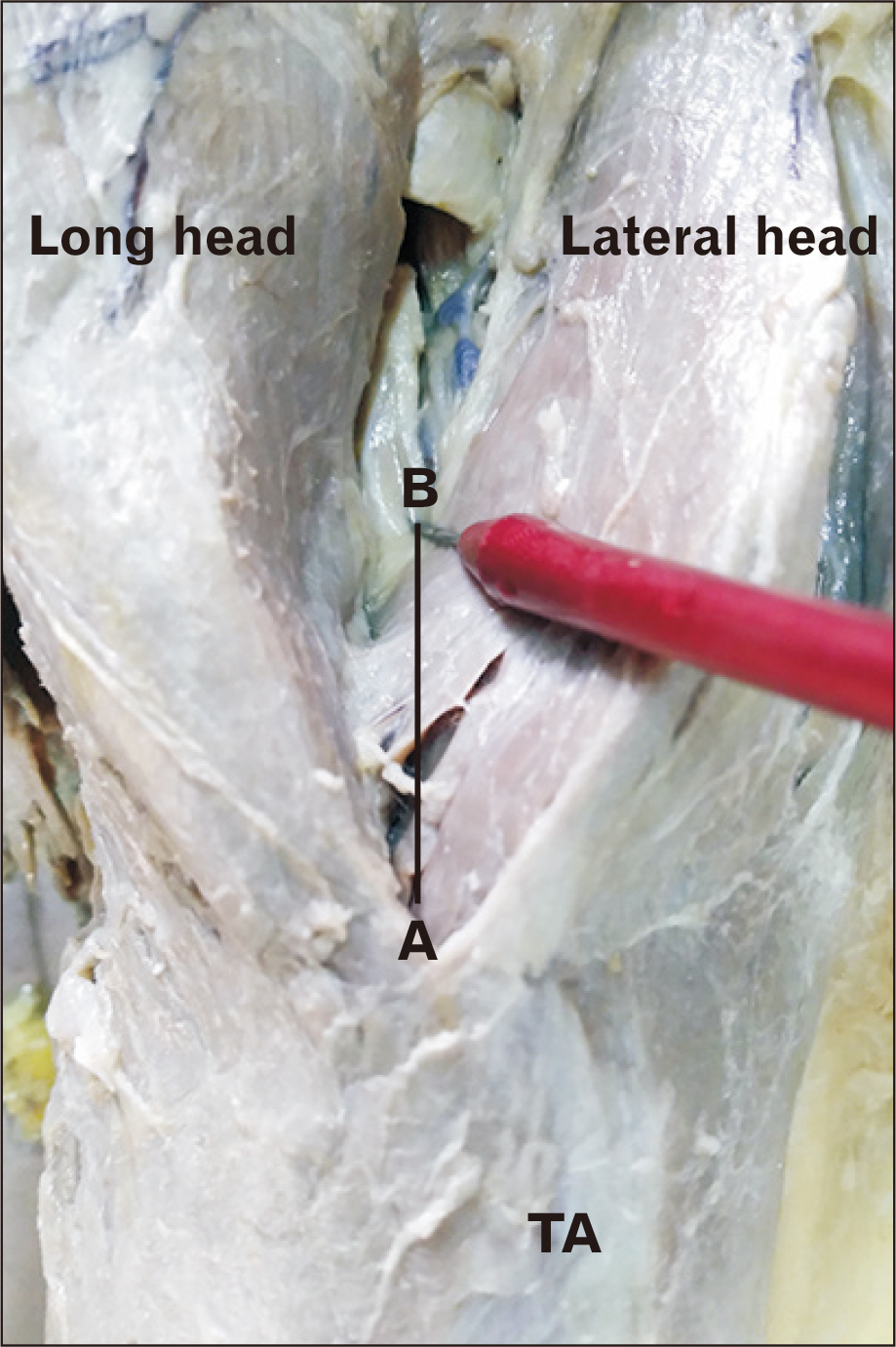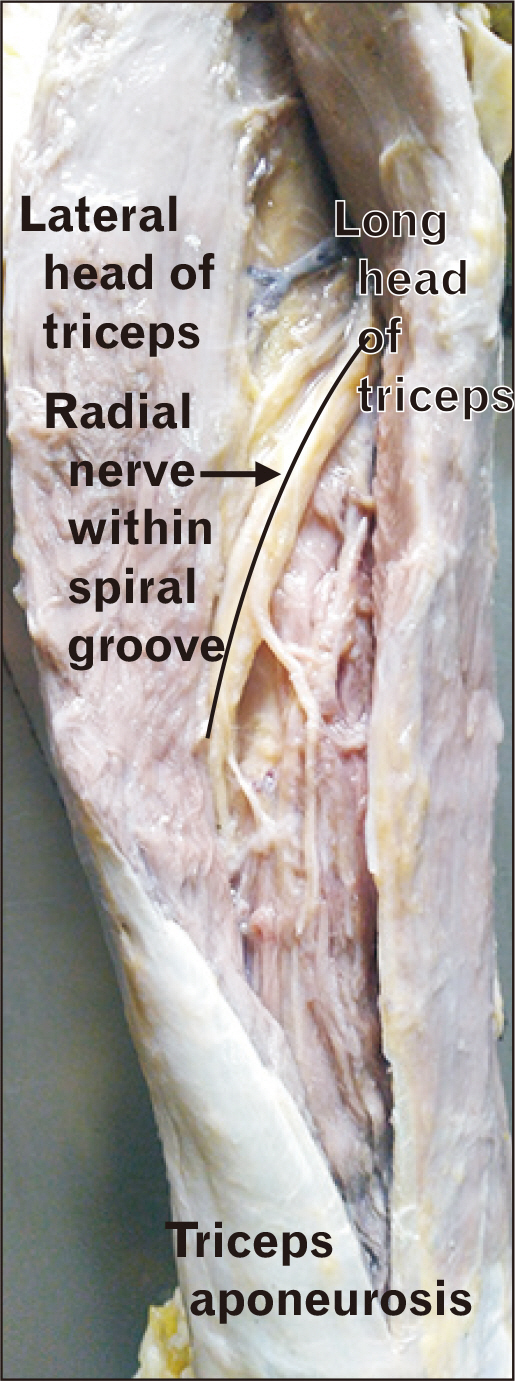Anat Cell Biol.
2020 Jun;53(2):132-136. 10.5115/acb.20.075.
Identification of most consistent and reliable anatomical landmark to locate and protect radial nerve during posterior approach to humerus: a cadaveric study
- Affiliations
-
- 1Department of Anatomy, All India Institute of Medical Sciences, Bathinda (Pb), India
- 2Department of Social and Preventive Medicine, Government Medical College, Patiala, India
- 3Department of Orthopedics, Government Medical College, Amritsar, India
- KMID: 2503442
- DOI: http://doi.org/10.5115/acb.20.075
Abstract
- The location of the radial nerve (RN) is described with various bony landmarks, but such may be disturbed in the setting of fracture and dislocation of bone. Alternative soft tissue landmarks would be helpful to locate the nerve in such setting. To recognize certain anatomic landmarks to identify, locate and protect RN from any iatrogenic injury during surgical intervention such as open reduction and internal fixation. Forty arms belonging to 20 adult cadavers were used for this study. We measured the distance of RN from the point of confluence of triceps aponeurosis (TA), tip of the acromion and tip of the lateral epicondyle along the long axis of the humerus. These distances were correlated with the upper arm length (UAL). The average UAL was 32.64±0.64 cm. The distance of the RN from the point of confluence of TA (tricepso-radial distance, TRD), tip of acromion (acromion-radial distance) and tip of lateral epicondyle of humerus (condylo-radial distance, CRD) was 3.59±0.16 cm, 14.27±0.59 cm, and 17.14±1.29 cm respectively. No correlation was found with UAL. Statistically, TRD showed the least variability and CRD showed maximum variability. The minimum TRD was found to be 3.00 cm. So this should be considered as the maximum permissible length of the triceps split. The point of confluence of the TA appears to be the most stable and reliable anatomic landmark for localization of the RN during the posterior approach to the humerus.
Keyword
Figure
Reference
-
1. Fleming P, Lenehan B, Sankar R, Folan-Curran J, Curtin W. 2004; One-third, two-thirds: relationship of the radial nerve to the lateral intermuscular septum in the arm. Clin Anat. 17:26–9. DOI: 10.1002/ca.10181. PMID: 14695584.
Article2. Standring S. Gray H, Standring S, Ellis H, Berkovitz BKB, editors. 2005. Upper arm. Gray's anatomy: the anatomical basis of clinical practice. 39th ed. Elsevier Churchill Livingstone;Edinburgh: p. 851–8.3. Mohler LR, Hanel DP. 2006; Closed fractures complicated by peripheral nerve injury. J Am Acad Orthop Surg. 14:32–7. DOI: 10.5435/00124635-200601000-00006. PMID: 16394165.
Article4. Shao YC, Harwood P, Grotz MR, Limb D, Giannoudis PV. 2005; Radial nerve palsy associated with fractures of the shaft of the humerus: a systematic review. J Bone Joint Surg Br. 87:1647–52. DOI: 10.1302/0301-620X.87B12.16132. PMID: 16326879.5. Wang JP, Shen WJ, Chen WM, Huang CK, Shen YS, Chen TH. 2009; Iatrogenic radial nerve palsy after operative management of humeral shaft fractures. J Trauma. 66:800–3. DOI: 10.1097/TA.0b013e31816142cf. PMID: 19276756.
Article6. Hoppenfeld S, De Boer PG, Buckley R. 2009. Surgical exposures in orthopaedics: the anatomic approach. 4th ed. Wolters Kluwer/Lippincott Williams & Wilkins Health;Philadelphia:7. DeFranco MJ, Lawton JN. 2006; Radial nerve injuries associated with humeral fractures. J Hand Surg Am. 31:655–63. DOI: 10.1016/j.jhsa.2006.02.013. PMID: 16632062.
Article8. Seigerman DA, Choung EW, Yoon RS, Lu M, Frank MA, Gaines LC, Liporace FA. 2012; Identification of the radial nerve during the posterior approach to the humerus: a cadaveric study. J Orthop Trauma. 26:226–8. DOI: 10.1097/BOT.0b013e31821d0200. PMID: 21918485.9. Artico M, Telera S, Tiengo C, Stecco C, Macchi V, Porzionato A, Vigato E, Parenti A, De Caro R. 2009; Surgical anatomy of the radial nerve at the elbow. Surg Radiol Anat. 31:101–6. DOI: 10.1007/s00276-008-0412-8. PMID: 18795220.
Article10. Bono CM, Grossman MG, Hochwald N, Tornetta P 3rd. 2000; Radial and axillary nerves. Anatomic considerations for humeral fixation. Clin Orthop Relat Res. (373):259–64. DOI: 10.1097/00003086-200004000-00032. PMID: 10810486.11. Carlan D, Pratt J, Patterson JM, Weiland AJ, Boyer MI, Gelberman RH. 2007; The radial nerve in the brachium: an anatomic study in human cadavers. J Hand Surg Am. 32:1177–82. DOI: 10.1016/j.jhsa.2006.07.001. PMID: 17923300.
Article12. Chou PH, Shyu JF, Ma HL, Wang ST, Chen TH. 2008; Courses of the radial nerve differ between Chinese and Caucasians: clinical applications. Clin Orthop Relat Res. 466:135–8. DOI: 10.1007/s11999-007-0019-0. PMID: 18196385. PMCID: PMC2505296.13. Cox CL, Riherd D, Tubbs RS, Bradley E, Lee DH. 2010; Predicting radial nerve location using palpable landmarks. Clin Anat. 23:420–6. DOI: 10.1002/ca.20951. PMID: 20196128.
Article14. Kamineni S, Ankem H, Patten DK. 2009; Anatomic relationship of the radial nerve to the elbow joint: clinical implications of safe pin placement. Clin Anat. 22:684–8. DOI: 10.1002/ca.20831. PMID: 19637299.
Article15. Guse TR, Ostrum RF. 1995; The surgical anatomy of the radial nerve around the humerus. Clin Orthop Relat Res. (320):149–53. DOI: 10.1097/00003086-199511000-00025.
Article16. Gerwin M, Hotchkiss RN, Weiland AJ. 1996; Alternative operative exposures of the posterior aspect of the humeral diaphysis with reference to the radial nerve. J Bone Joint Surg Am. 78:1690–5. DOI: 10.2106/00004623-199611000-00008. PMID: 8934483.
Article17. Lusweti V, Oluoch R, Ayumba BR, Njoroge A, Elbadawi MGY. 2019; The course of the radial nerve in relation to the humerus: a cadaveric study in a Kenyan adult population. East African Orthopaedic Journal. 13:20–5.18. Arora S, Goel N, Cheema GS, Batra S, Maini L. 2011; A method to localize the radial nerve using the 'apex of triceps aponeurosis' as a landmark. Clin Orthop Relat Res. 469:2638–44. DOI: 10.1007/s11999-011-1791-4. PMID: 21286885. PMCID: PMC3148375.
Article19. Ashfaq Hasan S, Rauls RB, Cordell CL, Bailey MS, Nguyen T. 2014; "Zone of vulnerability" for radial nerve injury: anatomic study. J Surg Orthop Adv. 23:105–10. DOI: 10.3113/JSOA.2014.0105. PMID: 24875341.
Article20. Prasad M, Isaac M, Premkumar PS. 2018; Anatomic landmarks to identify the radial nerve during the posterior approach of the humerus: a cadaveric study. J Clin Diagn Res. 12:1–4. DOI: 10.7860/JCDR/2018/37922.12275.
Article
- Full Text Links
- Actions
-
Cited
- CITED
-
- Close
- Share
- Similar articles
-
- Medial Transposition of Radial Nerve in Distal Humerus Shaft Fracture: A Report of Six Cases
- Tendon transfer for paralysis of radial nerve in the hand: Report of two cases
- A modified trans-anconeus approach to facilitate fixation of a posterior radial head fracture: a cadaveric feasibility study
- Posterior Dual Plating for Distal Shaft Fractures of the Humerus
- Contributing Factors of Radial Nerve Palsy Associated with Humeral Shaft Fracture





